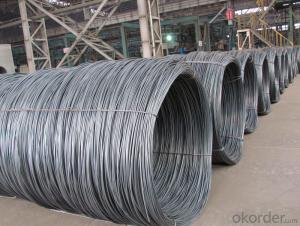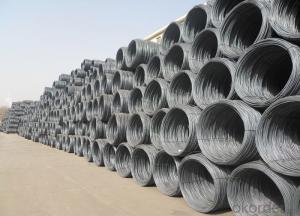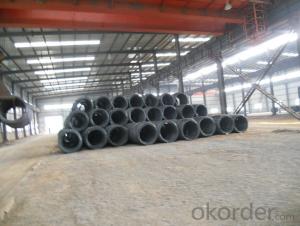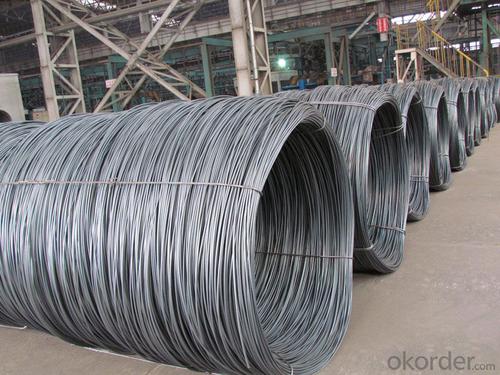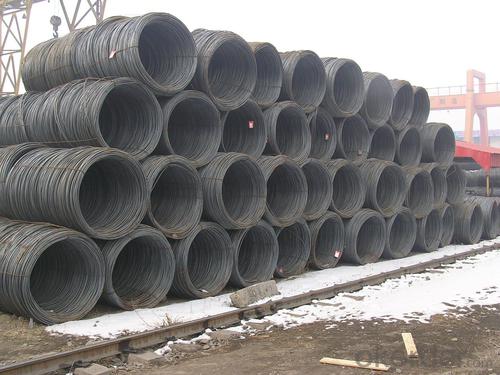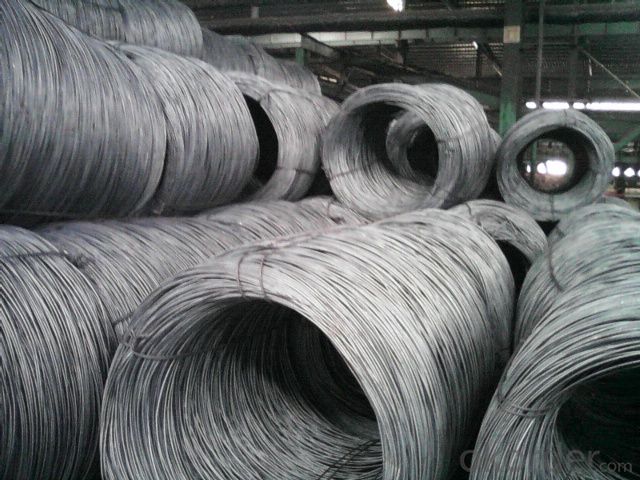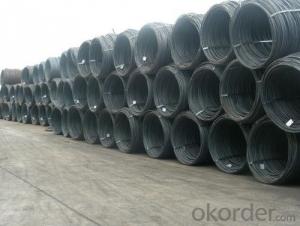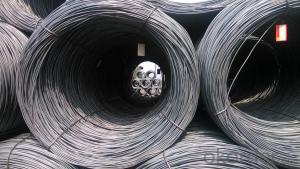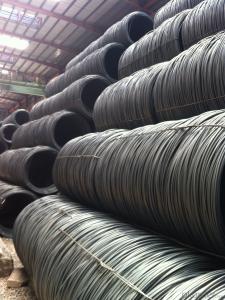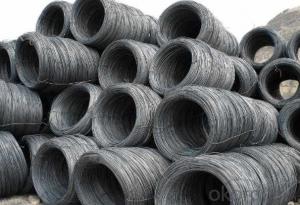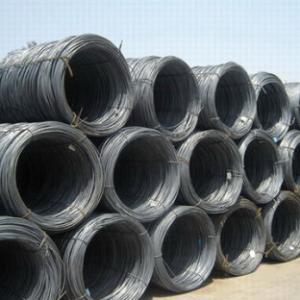Prime Alloy Hot Rolled Wire Rod in Low Carbon
- Loading Port:
- China main port
- Payment Terms:
- TT OR LC
- Min Order Qty:
- 100 m.t.
- Supply Capability:
- 10000 m.t./month
OKorder Service Pledge
OKorder Financial Service
You Might Also Like
Specification
Product Description:
OKorder is offering Prime Alloy Hot Rolled Wire Rod in Low Carbon at great prices with worldwide shipping. Our supplier is a world-class manufacturer of steel, with our products utilized the world over. OKorder annually supplies products to African, South American and Asian markets. We provide quotations within 24 hours of receiving an inquiry and guarantee competitive prices.
Product Applications:
Prime Alloy Hot Rolled Wire Rod in Low Carbon are ideal for structural applications and are widely used in construction and manufacturing. Carbon steel wire rod is mainly used for reinforcement of reinforced concrete and welded structure or reprocessed (roberts , nail, etc.) materials, especially used to produce wire drawing, welding electrode, nails, spring, electronic, precise machinery parts and so on.
Product Advantages:
OKorder's Prime Alloy Hot Rolled Wire Rod in Low Carbon are durable, strong, and wide variety of sizes.
Main Product Features:
· Premium quality
· Prompt delivery & seaworthy packing (30 days after receiving deposit)
· Can be recycled and reused
· Mill test certification
· Professional Service
· Competitive pricing
Product Specifications:
Manufacture: Hot rolled
Grade: HRB400,HRB400E,HRB500
Certificates: ISO, SGS, BV, CIQ
Packaging: Export packing, nude packing, in coils, each coil around 2mt
Size: 5.5mm, 6.5mm, 8mm, 10mm
Chemical composition (%): | C | Si | Mn | P | S | Ceq | |||
HRB335 HRBF335 |
0.25 |
0.80 |
1.60 |
0.045 |
0.045 | 0.52 | |||
HRB400 HRBF400 | 0.54 | ||||||||
HRB500 HRBF500 | 0.55 | ||||||||
Mechanical properties | Steel | Rel/ MPa | Rm/ MPa | A/ % | Agt/ % | ||||
≥ | |||||||||
HRB335 HRBF335 | 335 | 455 | 17 |
7.5 | |||||
HRB400 HRBF400 | 400 | 540 | 16 | ||||||
HRB500 HRBF500 | 500 | 630 | 15 | ||||||
FAQ:
Q1: Why buy Materials & Equipment from OKorder.com?
A1: All products offered byOKorder.com are carefully selected from China's most reliable manufacturing enterprises. Through its ISO certifications, OKorder.com adheres to the highest standards and a commitment to supply chain safety and customer satisfaction.
Q2: How do we guarantee the quality of our products?
A2: We have established an advanced quality management system which conducts strict quality tests at every step, from raw materials to the final product. At the same time, we provide extensive follow-up service assurances as required.
Q3: How soon can we receive the product after purchase?
A3: Within three days of placing an order, we will arrange production. The normal sizes with the normal grade can be produced within one month. The specific shipping date is dependent upon international and government factors, the delivery to international main port about 45-60days.
Images:
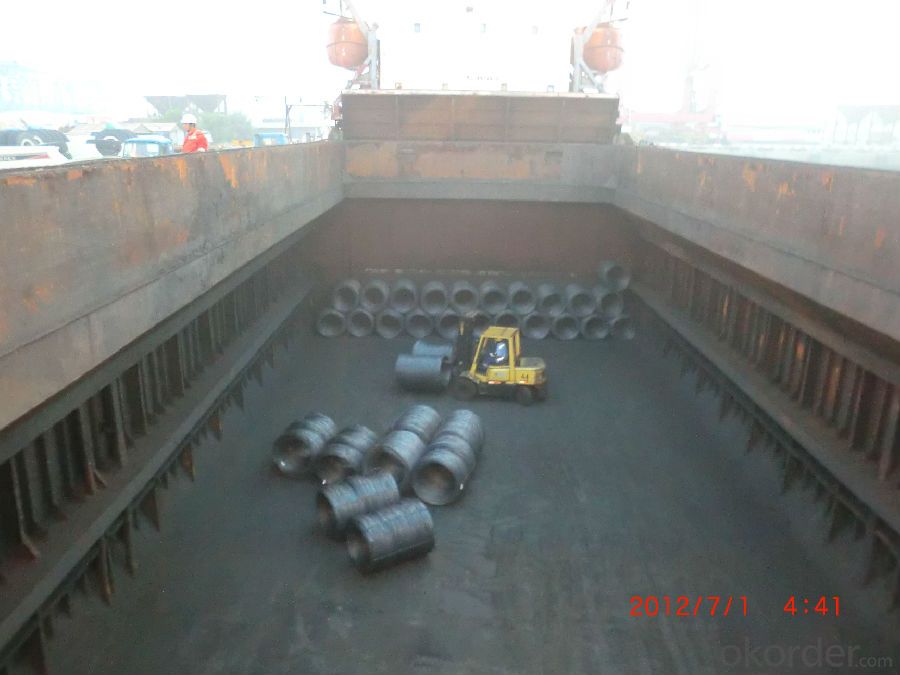
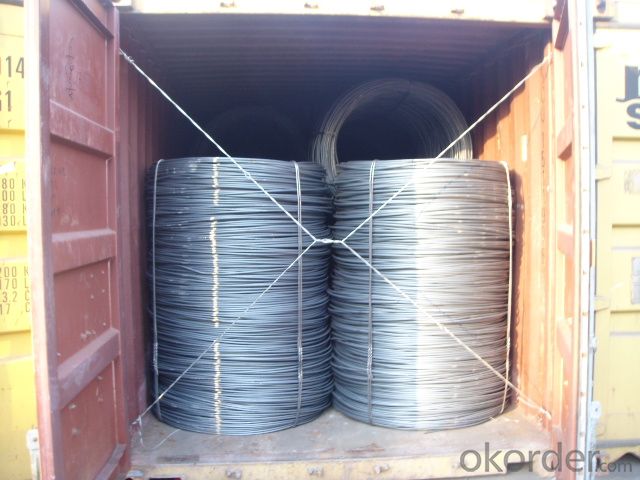
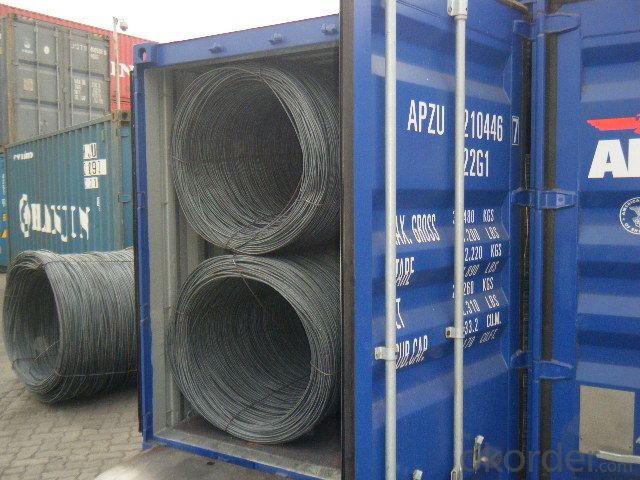
- Q: What are the common welding techniques used for steel wire rod?
- The common welding techniques used for steel wire rod include gas metal arc welding (GMAW), flux-cored arc welding (FCAW), and submerged arc welding (SAW).
- Q: What are the different sizes and dimensions of steel wire rod?
- Steel wire rods are available in a variety of sizes and dimensions to accommodate different industrial and commercial uses. The intended use and manufacturing standards typically determine the sizes and dimensions of steel wire rods. The diameter of steel wire rods can vary from as small as 0.1 millimeters (mm) to as large as 60 mm or more. Generally, the most common sizes in the market range between 5 mm and 20 mm in diameter. However, specialized applications may necessitate wire rods with larger or smaller diameters. The length of steel wire rods can vary significantly depending on the requirements. They are often produced in coils, which can range in length from a few meters to several kilometers. The length of wire rods can be customized to meet the customer's needs or industry standards. Regarding dimensions, steel wire rods are typically manufactured in a round shape. However, they can also be produced in other shapes such as square, rectangular, or hexagonal, depending on the specific application. The most prevalent shape is round because it provides excellent strength and flexibility for various uses. Furthermore, the weight of steel wire rods can vary based on the diameter and length. Usually, the weight is measured in kilograms (kg) or pounds (lb). The weight per unit length is determined by the specific gravity of the steel and the diameter of the wire rod. In conclusion, the sizes and dimensions of steel wire rods are extensive and can be customized to meet specific requirements. Whether it is for construction, automotive, or other industries, steel wire rods are available in a wide range of sizes to accommodate various applications.
- Q: How is steel wire rod used in the manufacturing of mattress springs?
- Steel wire rod is used in the manufacturing of mattress springs as it provides the necessary strength and durability required for supporting the weight and movement of the mattress. The wire rods are typically shaped into coils and then interconnected to form the spring units, which provide the necessary support and comfort for a mattress.
- Q: How is steel wire rod used in the manufacturing of wire for musical instrument strings?
- Steel wire rod is a crucial raw material used in the manufacturing of wire for musical instrument strings. It is first drawn through a series of dies to achieve the desired diameter and shape. This process ensures that the wire is strong, durable, and has the necessary flexibility to produce the desired musical tones. The wire is then further processed, coated, and wound onto specific cores to create strings for various musical instruments, such as guitars, pianos, violins, and cellos. The quality and properties of the steel wire rod directly impact the sound quality, longevity, and performance of the instrument strings.
- Q: What are the common surface treatments for steel wire rod?
- Steel wire rods can undergo various surface treatments to improve their appearance, durability, and resistance to corrosion. One popular treatment is galvanization, which involves applying a layer of zinc to the rod. This zinc coating acts as a protective barrier against rust and corrosion, making galvanized wire rods suitable for outdoor use and harsh environments. Phosphating is another common treatment, where a phosphate coating is applied to the steel wire rod. This coating enhances the adhesion of subsequent coatings or paints, making it ideal for wire rods that will undergo further processing or painting. Powder coating is a third treatment option, where a dry powder is applied to the rod and then cured under heat. This creates a durable and attractive finish that resists chipping, scratching, and fading. Powder coating is commonly used in applications that require both aesthetics and durability, such as furniture, automotive parts, and appliances. In addition, steel wire rods can undergo pickling, where they are immersed in an acid solution to remove any surface scale or impurities, or electroplating, which involves depositing a thin layer of metal onto the wire rod to enhance its appearance and corrosion resistance. Ultimately, the choice of surface treatment for steel wire rods depends on the specific requirements of the application. By selecting the appropriate treatment, the wire rod can be protected and enhanced to meet desired performance and aesthetic standards.
- Q: How is steel wire rod used in the manufacturing of wire forms for power lines?
- Steel wire rod is an essential component in the manufacturing of wire forms for power lines due to its strength, durability, and conductivity. The wire rod is first processed through a series of manufacturing steps to transform it into wire forms suitable for power transmission purposes. To begin with, the steel wire rod is typically hot-rolled to achieve the desired diameter and shape. This process involves passing the rod through a series of rollers that apply pressure and heat, resulting in a long, continuous wire. The hot-rolled wire is then cooled to increase its strength and hardness. Next, the wire is usually subjected to a drawing process. This involves pulling the wire through a series of dies with progressively smaller openings, which reduces its diameter and increases its tensile strength. This step also helps to improve the wire's surface finish and overall quality. After the wire is drawn to the desired size, it undergoes various treatments to enhance its mechanical properties. These treatments may include annealing, where the wire is heated and slowly cooled to relieve internal stresses and improve ductility. The wire may also be galvanized or coated with a protective layer to enhance its corrosion resistance. Once the wire is properly processed and treated, it can be transformed into various wire forms used in power line applications. For example, the wire may be coiled to create transmission lines that carry electricity over long distances. It can also be formed into overhead conductors or ground wires that are suspended on power line towers to transmit electrical energy. In addition to its strength and durability, steel wire rod offers excellent electrical conductivity, making it an ideal material for power line applications. The high conductivity allows for efficient transmission of electricity across the wire forms, minimizing energy losses during transmission. Overall, steel wire rod plays a crucial role in the manufacturing of wire forms for power lines by providing the necessary strength, durability, and conductivity required for efficient and reliable power transmission.
- Q: What are the common production processes for rhodium-coated steel wire rod?
- The common production processes for rhodium-coated steel wire rod typically involve wire drawing, cleaning, coating, drying, and final inspection.
- Q: How is steel wire rod stored and handled to prevent damage?
- To maintain the quality and performance of steel wire rod, it is necessary to handle and store it carefully. Several measures are commonly taken to ensure the integrity of the wire rod. To begin with, a designated area that is clean, dry, and well-ventilated is used for storing steel wire rod. This helps to minimize the risk of moisture exposure, which can lead to corrosion and rusting. Additionally, the storage area should be kept away from potential sources of damage such as heavy machinery, sharp objects, or chemicals that can cause surface abrasions or chemical reactions. To prevent physical damage, steel wire rod is often placed on pallets or racks to keep it off the ground and protect it from impacts or contamination. The stacking height should be limited to avoid excessive pressure on the lower layers, which can cause deformation or breakage. Moreover, steel wire rod is typically bundled or coiled to provide extra protection during storage and transportation. Bundling helps to maintain the shape and integrity of the wire rod, preventing bending or warping. Coiling is commonly used for longer lengths of wire rod and offers better handling and storage options. Proper training in safe lifting and transportation techniques is essential for personnel handling steel wire rod to prevent accidents that could damage it. The use of suitable lifting equipment, such as cranes or forklifts, is recommended to minimize the risk of dropping or mishandling the wire rod. Regular inspections should also be carried out to identify and address any signs of damage or deterioration, such as surface rust, dents, or deformations. Any damaged wire rod should be promptly removed from storage and replaced to prevent further deterioration or potential safety hazards. By following these storage and handling practices, the quality and performance of steel wire rod can be effectively preserved throughout its lifespan.
- Q: What are the common industry competencies for steel wire rod suppliers?
- Some common industry competencies for steel wire rod suppliers include expertise in steel production and manufacturing processes, knowledge of industry standards and regulations, ability to meet quality and performance requirements, strong supply chain management skills, excellent customer service, and a track record of delivering products on time. Additionally, suppliers should have a strong understanding of market trends and the ability to adapt to changing customer needs.
- Q: How is steel wire rod used in the manufacturing of wire forms for communication cables?
- Steel wire rod plays a vital role in the manufacturing process of wire forms for communication cables. It serves as the foundational material from which wires are derived. Once obtained, the steel wire rod goes through a sequence of procedures to transform it into wire forms suitable for communication cables. To begin with, the steel wire rod is thoroughly cleansed and inspected to identify any defects or impurities. This guarantees that the resulting wire forms meet the required standards and are of the utmost quality. Once cleansed, the steel wire rod is heated to a specific temperature and passed through a set of dies. This process, referred to as drawing, reduces the diameter of the wire rod while increasing its length. Subsequent to the drawing process, the steel wire rod undergoes further processing to enhance its mechanical properties. This may involve annealing, a heat treatment method that enhances the wire's flexibility and reduces its brittleness. Additionally, the wire may undergo various surface treatments to augment its resistance to corrosion or provide insulation. Once the wire forms are manufactured, they are utilized in the production of communication cables. These wire forms can function as conductive elements within the cables, enabling the transmission of electrical signals. Moreover, the wire forms can be utilized as structural components, imparting strength and support to the cables. In the manufacturing of communication cables, the steel wire rod guarantees the production of high-quality wire forms that meet the specific requirements of these cables. The durability, flexibility, and conductivity of the wire forms contribute to the efficient and reliable transmission of information through the communication cables.
Send your message to us
Prime Alloy Hot Rolled Wire Rod in Low Carbon
- Loading Port:
- China main port
- Payment Terms:
- TT OR LC
- Min Order Qty:
- 100 m.t.
- Supply Capability:
- 10000 m.t./month
OKorder Service Pledge
OKorder Financial Service
Similar products
Hot products
Hot Searches
Related keywords
